 Talent Enablement Guide for a SAFe© Organization in FinTech
Talent Enablement Guide for a SAFe© Organization in FinTech
By Fabiola Eyholzer, Agile HR Thought Leader & Michael Stump, SAFe Fellow and SPCT
Note: This article is part of the SAFe Beyond IT series, and it offers real-world Business Agility experiences in Operational Value Streams written and contributed by SAFe professionals.
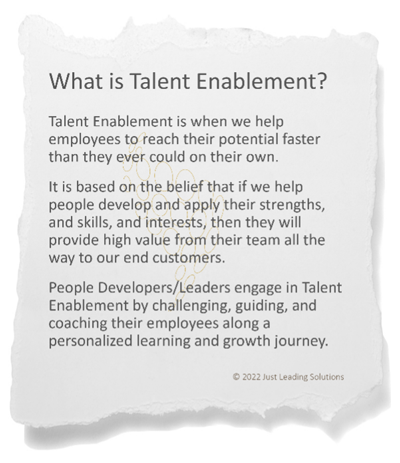 Abstract
Abstract
This is the story of a FinTech company and its dedicated leaders who started their SAFe transformation by putting people first. They took the premise of people as a critical success to the next level.
Their journey started in 2015 with the implementation of SAFe across Product Development. The company understood the importance of people and introduced the crucial role of People Developer – a leadership role responsible for all people-related topics on the ART.
Four years later, they looked back at a highly successful SAFe transformation. However, they were far from done. Instead, the leadership team identified several initiatives, many of them surrounding the work of the People Developer. This experience report is about one of these innovative initiatives on Talent Enablement (TE). This is the story of our interdisciplinary team and our journey creating a Talent Enablement Guide (TEG).
Context
When the company established the role of People Developer, it was a new field for many of the two dozen People Developers. Together, they had to carve out their role and find their footing.
The People Developers had various practices and tools at their disposal, and they did their best to adapt them to Agile, but overall, there was no clear playbook and limited alignment across nine ARTs and five countries. As a result, different leadership styles and adaptations of people processes emerged.
Initially, this posed little problem. It was valuable to experiment and cater to the demands of local teams. However, over time, employees started to perceive many practices as unfair and outdated. And the competing world views between the Agile part of the business and the rest of the organization exacerbated the situation.
Senior Executives held on firmly to their leadership views, most notably around Performance Management. And independently from Product Development, HR worked on various strategic initiatives on the same or similar topics. However, they had to design an approach that satisfied the needs of the whole organization, not just the Agile part of the business.
For People Development, this usually meant pushing back on well-intended philosophies and practices. But the lack of internal alignment made it more challenging to offer a united front when dealing with Senior Leadership and Corporate HR.
Something had to change, and the first step was taking a step back and becoming more knowledgeable in Agile HR.
Actions
Defining the Initiative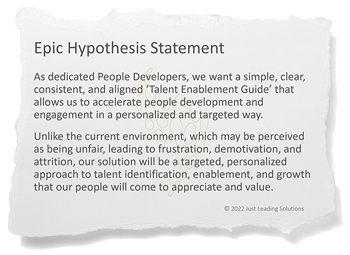
In December 2019, all People Developers went through a master class in Agile HR for People Leaders provided by JLS, a specialized Agile HR transformation consultancy. The Heads of People Development, the Head of Product Development, HR Business Partners, and the entire LACE team also attended the multi-day session.
Next was an experimentation and exploration phase to a) apply learnings and b) identify and analyze critical challenges. In early February 2020, the participants shared their insights in a follow-up deep dive, which was also used to create Epic Hypothesis Statements for various problem statements. In the end, the group collectively prioritized the lack of vocabulary and alignment around their talent approach.
Unbeknownst to all involved, this would be the last time all People Developers would meet in person for the next two years.
Shortly afterward, an initiative was approved to accelerate people development and engagement in a personalized and targeted way. Coined ‘Talent Enablement Guide’ (TEG), the concepts and guide itself had to be simple, clear, and consistent; and should potentially align with other HR processes.
Getting Started
An interdisciplinary team of People Developers and HR professionals went to work under the guidance and support of an external Agile HR Consultant, with an extensive background in HR, who is also a certified SPC. The team was championed by a steering committee representing People Development, Product Development, LACE, Senior HR Leadership, and other stakeholders.
In mid-May 2020, we finally kicked off with a two-day working session to refine the Epic Hypothesis Statement from the master class, define the Component and Solution MVP, create the Feature Backlog, map out the initiative Roadmap, and outline a Working Hypothesis. The team was now ready to co-create in 2-week iterations with bi-weekly review sessions with the steering committee.
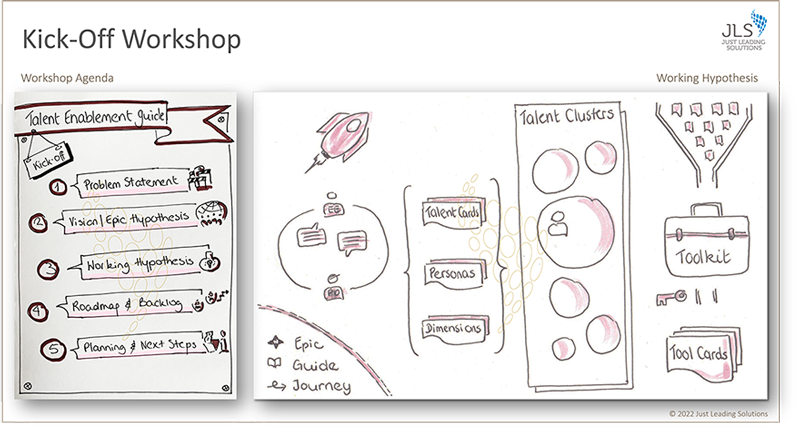
Co-Creating and Experimenting
The first order of business was redefining the meaning of ‘Performance’ and ‘Talent’ for a more holistic and adequate approach to value contributions and dimensions. After all, Geoff the Glue and Lisa the Unsung Hero are just as valuable to the team as Ted the Techie and Susie Superstar – even if they contribute in different ways.
From there, we started building a way to a more personalized yet targeted approach that ensures consistency and alignment across all ARTs.
First, we defined talent clusters and personas to a) help find and personalize suitable learning and growth opportunities such as knowledge sharing programs and exploratory assignments and b) identify missing tools or under-/overrepresented groups.
Next, we elevated an already existing process of regular check-ins to challenge, guide, and coach individuals in a way that aligns with the principles of TE. This led to the introduction of Talent Pipeline Dialogues to assess the strengths, weaknesses, and longevity of their overall talent pipeline and explore improvement or corrective steps.
From there, we moved into the experimentation phase involving almost the entire People Development team. It was their first introduction to the complete concept, and we received fast feedback that allowed us to improve and finalize the TEG.
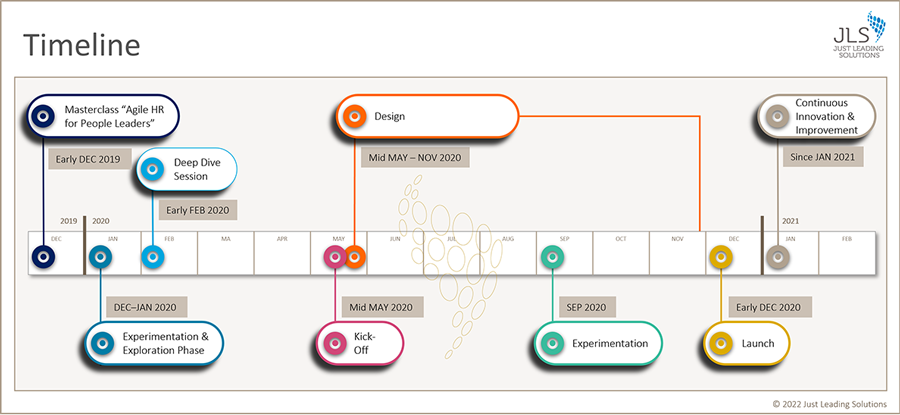
Result
We launched the Talent Enablement Guide in early December 2020.
The initial guide consisted of a common language: dimensions to help understand value contribution, personas to give better insight into personality types, talent clusters to group people with similar value contribution, and a toolkit of suggested tools and techniques to use for each persona or cluster. It also provided a process around talent pipeline discussions to understand and align around possibilities and challenges across all trains.
The TEG team and steering committee members recorded all introductory and explanatory videos and welcome messages personally.
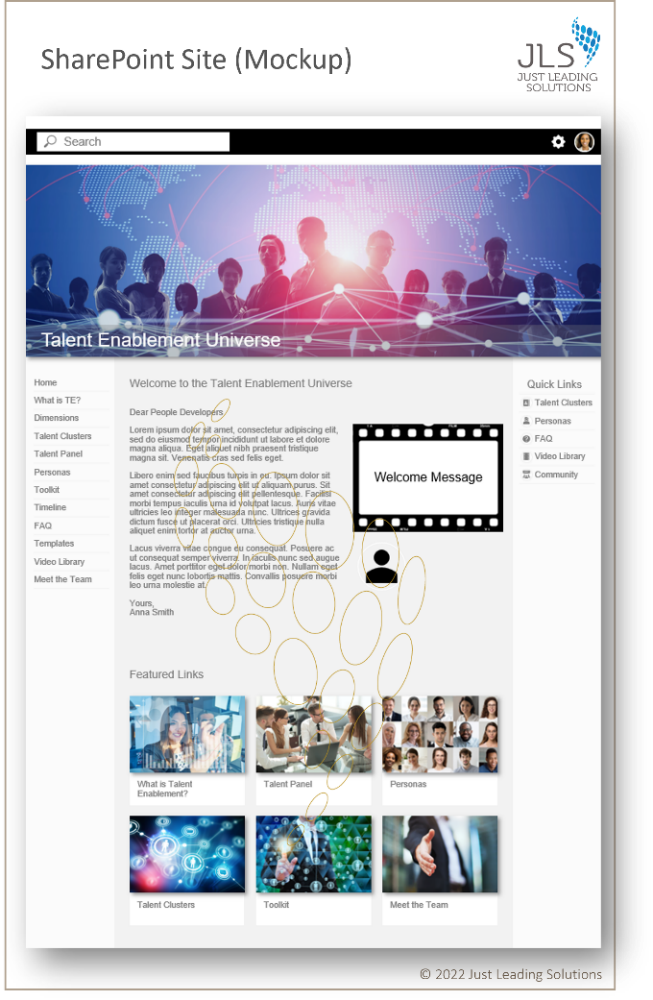
But the TEG is not a guide in the traditional sense. Instead of a manual, we created a SharePoint community site for People Developers to find answers and content, but also share experiences and inspire others. As a result, it is a community-based guide that is continuously evolving. The more People Developers learn and co-create, the more valuable the guide becomes.
TEG helps the ARTs to:
- Redefine the terms ‘Performance’ and ‘Talent’ in line with Agile
- Increase the strength and quality of the talent pipeline
- Gain an overview of the strength and weaknesses of the current talent pipeline
- Maximize the value of available (and future) people/HR tools and techniques
- Create transparency, alignment, and dialogue across all levels and units
- Improve employee satisfaction and appreciation, enrich learning and growth opportunities, ensure more robust talent scouting, and more talent mobility
- Engage in relentless development of people in a way that they constantly deliver significant value
- With the site launch, a new era of Talent Enablement was officially underway. It was a fitting end to 2020 – a year filled with unprecedented change.
A Solution in True Agile Fashion
The ‘final’ solution was very different from the initial idea. When the leadership team approved the initiative, many envisioned a Word or PowerPoint manual filled with how-tos and dos & don’ts. Instead, they were amazed and delighted about a solution, i.e., the community-based SharePoint site, that went well beyond their expectations and was refreshingly different.
For some of the HR Business Partners and Senior HR Leaders involved, it was the first real exposure to Agile. Throughout the initiative, they gained an appreciation for the powers of Agile, turning them into advocates and pushing the door wide open for HR Agility.
Takeaways
Lessons Learned
The joys and challenges of virtual work during the onset of the COVID-19 pandemic aside, our learnings are nothing new, but they are worth mentioning. But before we list our key lessons learned, here are our two honorary mentions: 1) the necessity to explore and experiment and 2) the importance of welcoming change even late in the process.
Agile is only one side of the Agile HR coin.
Expertise in Agile, no matter how extensive, is not enough to tackle Agile HR. The concepts of Agile HR go well beyond Agile practices, and understanding the complexity and dynamic of Agile HR is crucial. If a company does not have the expertise in-house, it pays off to get outside help and include HR from the start. We took HR on the journey as a team and steering committee members and benefited from their knowledge and input.
A lack of training will slow you down and impede your solutioning capabilities.
Not all team members went through the master class, but it did show how important it is to speak the same language and understand the underlying concepts (we know that from SAFe Training before launching an ART). There was a silver lining: it allowed team members to practice explaining concepts and ideas to people not versed in Agile HR. But there is no sugar coating; it slowed us down initially. Thankfully, we had experienced certified Agile HR consultants and practitioners on the team to ensure high-level ideation and solutioning capabilities.
Defining the ‘Why’ for a complex adaptive system is more critical and challenging than expected.
The most difficult but essential part of the process is defining the ‘Why’. We initially spent some time on it but struggled to get a final agreement, so we moved into the ideation phase – prematurely as it will turn out. Throughout the first few iterations, we kept hitting a wall when it came to exploring and evaluating ideas and solutions until we truly finalized the ‘Why’ for good.
Leadership/LACE Buy-in is not enough; active participation and investments are needed.
Many factors turned this initiative into a success, but none of it would have come to fruition without:
- The foresight and courage of the Head of Product Development to establish a People Authority right from the start of their SAFe transformation journey
- The determination and passion of the Heads of People Development to appoint amazing people and their continued investment in building a strong People Runway
- The unwavering support and leadership of the LACE team to champion and invest in Agile HR
- The trust and wisdom of Senior HR Leadership to come to the table with an open mind and be on the journey with us
They were and still are true Agile leaders. Buy-in and sign-off were never enough; they actively participated. None of them missed a single masterclass, workshop, or review session. Their ongoing support and insights were invaluable to the TEG team throughout the journey and beyond.
An interdisciplinary team that is unafraid of pushing boundaries and ready to be on a growth journey is critical.
As with any Agile initiative, co-creation is not without ups and downs. But our amazing TEG team of ambitious, hard-working Agile pioneers was eager to learn and was never afraid to challenge the status quo.
Every one of them brought something unique to the table. It was that diversity of thought, perspectives, experiences, and skills that formed a team capable of creating something exceptional. And that is exactly what they did. As they kept pushing boundaries on the TE front, they were on a fast-tracked growth journey themselves.
The Journey Continues
Talent Enablement is in its second year now, and it is still going strong. The People Development group is now more determined than ever to push the envelope. They continue to use, improve, and extend the TEG well beyond the initial idea. They are building a strong People Runway for the future.
Corporate HR has since embraced a few of the TEG concepts and tools. Because we developed them from a Systems Thinker’s perspective, we have a solid foundation for reinvention and integration of other people practices.
The real test is still ahead: challenging the compensation and incentive model. It will be another exciting journey. But that is a story for another day.





